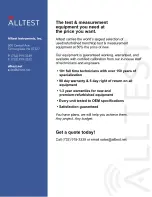
EX210T-EU-EN V1.1 8/12
3
PER IEC1010 OVERVOLTAGE INSTALLATION CATEGORY
OVERVOLTAGE CATEGORY I
Equipment of OVERVOLTAGE CATEGORY I is equipment for connection to circuits in which
measures are taken to limit the transient overvoltages to an appropriate low level.
Note – Examples include protected electronic circuits.
OVERVOLTAGE CATEGORY II
Equipment of OVERVOLTAGE CATEGORY II is energy-consuming equipment to be supplied from
the fixed installation.
Note – Examples include household, office, and laboratory appliances.
OVERVOLTAGE CATEGORY III
Equipment of OVERVOLTAGE CATEGORY III is equipment in fixed installations.
Note – Examples include switches in the fixed installation and some equipment for industrial use
with permanent connection to the fixed installation.
OVERVOLTAGE CATEGORY IV
Equipment of OVERVOLTAGE CATEGORY IV is for use at the origin of the installation.
Note – Examples include electricity meters and primary over-current protection equipment
CAUTIONS
Improper use of this meter can cause damage, shock, injury or death. Read and understand
this user manual before operating the meter.
Always remove the test leads before replacing the battery or fuses.
Inspect the condition of the test leads and the meter itself for any damage before operating the
meter.
Use great care when making measurements if the voltages are greater than 25 VAC rms or 35
VDC. These voltages are considered a shock hazard.
Warning! This is a Class A device. This device can cause interference in residential areas.
Always discharge capacitors and remove power from the device under test before performing
Diode, Resistance or Continuity tests.
Voltage checks on electrical outlets can be difficult and misleading because of the uncertainty
of connection to the recessed electrical contacts. Other means should be used to ensure that
the terminals are not "live".
If the equipment is used in a manner not specified by the manufacturer, the protection provided
by the equipment may be impaired.
This device must not be used by children. It contains hazardous objects as well as small parts
that the children could swallow.
Do not leave batteries and packing material lying around unattended; they can be dangerous
to children.
In the event that this device will be stored for an extended period of time, remove the batteries.
Expired or damaged batteries can leak and can be hazardous to skin. Use suitable hand
gloves in such cases.
Do not short-circuit the battery. Do not place the battery near a fire.
Never mix battery types. Always install new batteries of the same type.






























